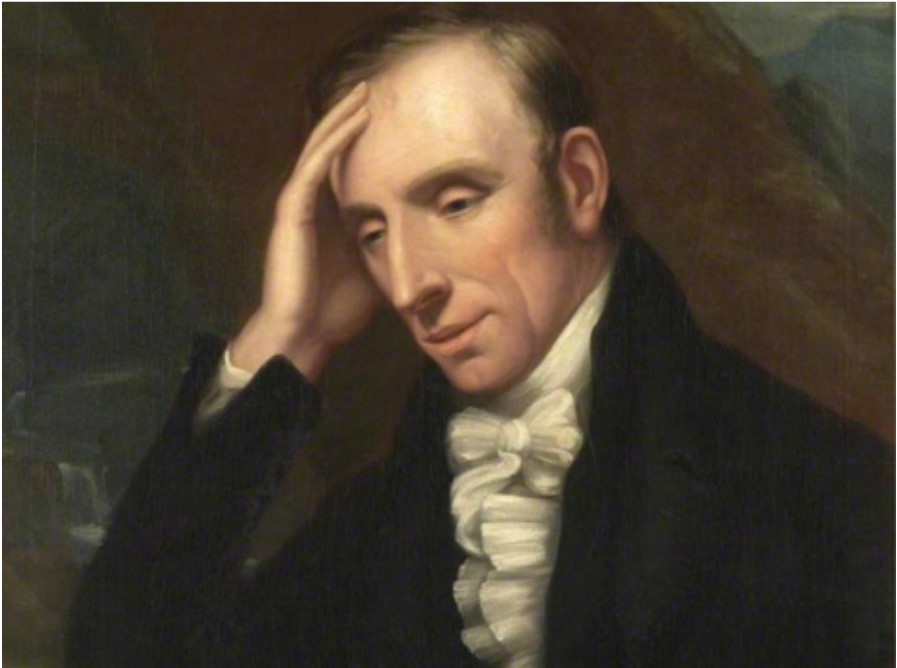Poetry
Lines Written in Early Spring by William Wordsworth

William Wordsworth (1770-1850)
Lines Written in Early Spring
I heard a thousand blended notes,
While in a grove I sate reclined,
In that sweet mood when pleasant thoughts
Bring sad thoughts to the mind.
To her fair works did Nature link
The human soul that through me ran;
And much it grieved my heart to think
What man has made of man.
Through primrose tufts, in that green bower,
The periwinkle trailed its wreaths;
And ’tis my faith that every flower
Enjoys the air it breathes.
The birds around me hopped and played,
Their thoughts I cannot measure:—
But the least motion which they made
It seemed a thrill of pleasure.
The budding twigs spread out their fan,
To catch the breezy air;
And I must think, do all I can,
That there was pleasure there.
If this belief from heaven be sent,
If such be Nature’s holy plan,
Have I not reason to lament
What man has made of man?
A Reflection on Spring, Wordsworth, and the Warming Earth
HeeSun Koh
As always, spring has returned this year. A warm breeze, laced with the fragrance of blossoms, gently brushes across my face. Plum blossoms, forsythias, azaleas, magnolias, cherry trees, and lilacs—this season, all bloom together in an unseasonal, brilliant chorus. The plum, ever the first to bloom, softly cradles my face in its petals. And as I inhale its fragrance—so delicate, deep, and noble—my heart lifts with quiet joy, as if touched by a pure and silent dawn. Then the golden forsythia brightens the world, and pink azaleas shimmer with vibrant charm. Magnolias bloom in elegant ivory, while cherry blossoms unfurl in tender puffs of pale pink.
In the past, spring arrived with a gentle order: In February, the plum blossoms opened. In March, the forsythias and azaleas followed. April brought magnolias and cherry blossoms, and in early May, small clusters of white and lavender lilacs unfurled, their fragrance soft and sweet. But this April, as I look around, they are all blooming together. Each flower—no longer waiting its turn—flaunts its beauty, as if summoned by some unknown urgency. Is the feeling I carry in this new spring one of wonder? Or is it a whisper of warning from this beautiful, yet strangely unfamiliar season—a season born of a warming Earth?
In William Wordsworth’s Lines Written in Early Spring, the poet begins with a scene of serene natural beauty. Reclining in a quiet grove filled with birdsong, blooming flowers, and the soft stirrings of the breeze, he finds himself in “that sweet mood when pleasant thoughts / Bring sad thoughts to the mind.” It is a moment of quiet joy tinged with sorrow—a feeling deeply rooted in Romanticism, where delight in nature coexists with the grief of human disconnection from it.
Wordsworth writes not merely to describe what he sees, but to express what he believes. The bloom of primroses, the trailing periwinkle, birds hopping with secret joy, and twigs stretching to meet the wind—all suggest to him a sacred harmony in the natural world. “’Tis my faith that every flower / Enjoys the air it breathes,” he writes. It is not metaphorical, but spiritual. Nature, in his eyes, is alive, expressive, and woven into a divine moral order—a “holy plan.”
Yet even in this tranquil beauty, a shadow falls. As he reflects on what humanity has become, he mourns with the line, “What man has made of man.” It is not just a poetic sigh—it is a subtle indictment. Where nature lives in joy and harmony, humanity often strays, alienated and destructive. In Wordsworth’s lament, we feel the weight of a broken connection.
Today, his gentle sorrow feels more urgent than ever. In an era of ecological destruction, climate disruption, and social unrest, Wordsworth’s call to remember our bond with nature becomes a plea to restore it. He does not preach. Instead, he invites us into a quiet, reflective space—where awe and sorrow can awaken our conscience. As spring arrives once again, I find myself listening more closely—attuned not only to its beauty, but to something deeper. Is this the Earth blooming in splendor—or softly signaling something more?
In Wordsworth’s spring, I felt the soul of the season in every breeze and every bloom. Through his poetry, he invites us not merely to admire the natural world, but to pause, to remember—and to return—to the sacred connection we have long forgotten. Today, that invitation feels more urgent than ever. Global warming and climate change are no longer distant threats, but present challenges we can no longer ignore. To safeguard the Earth for future generations, we must take comprehensive action—transitioning to renewable energy, improving energy efficiency, adopting eco-friendly transportation, protecting forests through reforestation, promoting sustainable agriculture and dietary shifts, implementing carbon pricing mechanisms, and fostering international cooperation.
For the sake of future generations, we must diligently preserve the Earth’s ecosystems and natural environment—the very foundation of our lives. This responsibility begins not with grand declarations, but with the quiet, mindful choices we each make in our daily lives. So let us not ask whether one person’s gentle change can truly shape the world.
“If you bloom, and I bloom too,
might the meadows, in time,
become fields of flowers in full bloom? –Jo Donghwa(Korean Poet)”
William Wordsworth (born April 7, 1770, Cockermouth, Cumberland, England—died April 23, 1850, Rydal Mount, Westmorland) was an English poet whose Lyrical Ballads (1798), written with Samuel Taylor Coleridge, helped launch the English Romantic movement. The principles he outlines in the preface to the second edition of Lyrical Ballads (1800) were revolutionary. By seeking to compose poetry that reflects “incidents and situations from common life, and to relate or describe them, throughout, as far as was possible in a selection of language really used by men,” Wordsworth (with Coleridge) essentially changed English-language literature.
He was a major English Romantic poet known for his deep love of nature and his belief in its spiritual and moral influence on the human soul. Born in the Lake District of England, he lost both parents at a young age and found solace in the natural beauty around him. He studied at Cambridge University and later traveled to France, where he was initially inspired by the ideals of the French Revolution. However, the violence of the Revolution disillusioned him, and he turned inward, focusing on poetry that celebrated nature, childhood, and human emotion.
Wordsworth’s close friendship with fellow poet Samuel Taylor Coleridge led to the publication of Lyrical Ballads in 1798, a landmark in English literature that helped launch the Romantic movement. His major work, The Prelude, is a long autobiographical poem exploring the development of his mind and spirit through his relationship with nature. In 1843, he was appointed Poet Laureate of England. Wordsworth’s legacy lives on as one of the foundational figures of English Romanticism.
William Wordswort’s Literary Features
William Wordsworth is considered one of the central figures of English Romantic literature, and his poetry is distinguished by its emphasis on nature, human emotion, and the use of everyday language. His literary characteristics can be described as follows:
Love and Reverence for Nature
Wordsworth viewed nature not only as a backdrop but as a powerful medium through which to explore human emotions and the inner workings of the human soul. He believed nature had a divine and restorative power, often portraying it as a source of spiritual healing. In works like Tintern Abbey, he explores the profound connection between nature and the human psyche.
Use of Everyday Language
Unlike many of his predecessors who used formal, elevated language, Wordsworth chose to write in the language of ordinary people, believing that this style could better express the truth and emotion of human experience. His famous Lyrical Ballads marks a departure from conventional poetic diction, making it more accessible and grounded in the rhythms of daily life.
Emphasis on Personal Experience and Emotion
Personal experience and emotional depth are central to Wordsworth’s poetry. He often explored his own feelings and inner transformations, expressing them through vivid and intimate language. In poems like I Wandered Lonely as a Cloud, he reflects on personal experiences with nature, using them as a vehicle for exploring broader human emotions and connections.
Spiritual and Philosophical Symbolism of Nature
For Wordsworth, nature was not simply a setting but a deeply symbolic force connected to the human soul. His poems frequently present nature as a spiritual guide, offering wisdom, peace, and a means of self-discovery. Nature becomes a reflection of inner human growth, suffering, and joy.
Innovating Romanticism
Lyrical Ballads is considered a foundational work of Romanticism, emphasizing subjective emotion, individual experience, and the deep connection between humanity and nature. This book is a landmark collection of poems first published in 1798 by William Wordsworth and Samuel Taylor Coleridge. It is widely regarded as the beginning of the English Romantic movement in literature.
Time and Memory
Wordsworth often explored the passage of time and the significance of memory in shaping human identity. In poems like Ode: Intimations of Immortality, he examines how memories from childhood continue to influence and shape the adult mind, underscoring the importance of recollection and the persistence of emotional experiences across time.
Wordsworth’s contributions to literature are pivotal in the evolution of Romanticism, influencing generations of poets who followed his lead in exploring the depths of human emotion, nature, and memory.
April 19, 2025 — Gimpo, South Korea
the article is written by HeeSun
HeeSun, a poet and storybook writer, illuminates the world with her beautiful poems, songs, and stories, bringing hope and inspiration to those fortunate enough to experience her work. Through her global perspective and commitment to creative expression, HeeSun’s contributions extend beyond borders, weaving a beautiful tapestry of artistry that fosters connection and understanding. She is a member of both the International PEN Club and the Arts and Letters Club of Toronto.




